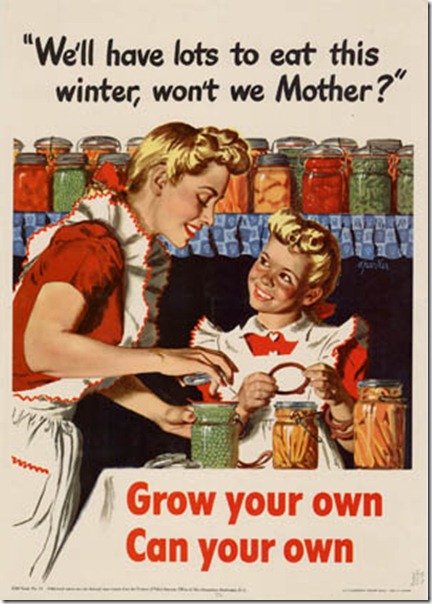I sort of stumbled into canning a couple years back when I stumbled on a you-pick farm just south of Tampa, Florida. Or perhaps I should say I stumbled back into canning, since I grew up in a family that raised and put up a lot of its own food. My mom and grandma’s spent every end of summer putting up fruit jams, beans, applesauce, applebutter and many other delights. So I’m no stranger to the hard, hot work involved, but until a couple of summers ago, I really thought that my days of tending a roiling canning kettle were through.
But, there were all these tomatoes I had picked, and my freezer was beyond full. And then a Craigslist “free stuff” post netted me 23 dozen canning jars, a canning kettle, and other miscellaneous equipment from a sweet old lady in Tampa who was moving and was absolutely delighted to pass on the canning torch to a new generation. “Bless your heart,” she kept saying as she loaded yet another dusty box of Mason jars (each carefully wrapped in old News Papers) into my arms.
So I bowed to the inevitable and canned eight dozen jars of tomato sauce and salsa. (Guess what everybody I knew got for Christmas that year?) And this year I did it again. My mom came down and she re-taught me how to can all kinds of different things, thus adding beans, apple butter and applesauce to my canning repertoire. I’ve become a canning fool–and I’m not alone. Lots of Gen-X and Gen-Y urbanites are assuming the mantle of home food preservation from our grandparents’ generation, or are at least vying to score their jars and equipment. Canning, it seems, has become cool.
I shouldn’t have been surprised. After all, many of my pals are big into retro-cool home-ec activities like knitting. The whole DIY vibe in conjunction with the local-foods movement made canning’s comeback only natural. And, really, it’s not that hard, especially if you don’t have to grow the grub yourself first. A few weekend days spent cruising the farmers’ market and hauling height-of-the-season fruits and vegetables home for an afternoon of canning is time well spent. It will pay off in the dead of winter, when peaches are hard or mealy, and in need of a passport in order to reach local stores. Those jars of juicy golden peaches, picked and processed at their peak, will taste heavenly by comparison–and, having gone nowhere in the meantime, remain locally grown.
Home-canned foods make some people paranoid, because of the possibilities of food-borne illness. What we’re talking about is Clostridium botulinum, one of the nastiest neurotoxins on the planet. The botulism organism itself is abundant in the environment but is killed by heat during the canning process; however, botulism’s hardy spores can survive boiling temperatures to thrive and multiply in the anaerobic environment of a sealed jar. Since the spores are odorless and tasteless and the toxin they produce can make you very, very sick or even dead, this is nothing to mess with.
However, there’s an extremely easy way to play it safe: lemon juice. Botulism cannot survive in an acid environment, and so canning acidic fruits like apples, peaches, or berries means no botulism risk. A little lemon juice squeezed into each jar not only ups the acid content but also makes the fruit taste sweeter by contrast. Tomatoes and anything in vinegar–a whole world of pickles and chutneys–are also terrific canning candidates. Higher pH veggies like green beans, however, are better frozen than canned, as botulism can’t survive below 32 degrees Fahrenheit, and canning them safely requires using a specialized pressure canner to heat them to a temperature well over boiling, rendering them tasteless and mushy.
For basic water-bath canning you really need only canning jars, lids, and sealing rings; a case of 12 costs about $10. You don’t need a dedicated canning kettle; any large pot will work to boil the jars, though they need to be raised up off the pot bottom lest the direct heat crack the glass. A canning kettle includes a removable rack for this purpose, but a vegetable steamer can work in a pinch. One handy tool is a jar lifter, a set of tongs designed to fit around the neck of a canning jar–without one it can be tricky to retrieve the jars from their boiling bath.
I came up with this green tomato chutney recipe last year in order to use up the bushel of hard green golf balls I picked the night before the first frost. It’s pretty good, if I do say so myself, and makes good use of late-season tomatoes.
Before you can anything, Go to the National Center for Home Canning at: https://nchfp.uga.edu/publications/publications_usda.html
Always follow the guidelines set forth by the National Center for Home Canning at the above link. Do NOT just go by what I may say in my recipes or videos as it could be wrong and cause health issues. I try my best to make sure everything is followed correctly for your safety, but you need to protect yourself and always follow the National Center for Home Canning guidelines whenever you can food yourself.
![]()
![]()












Be the first to comment